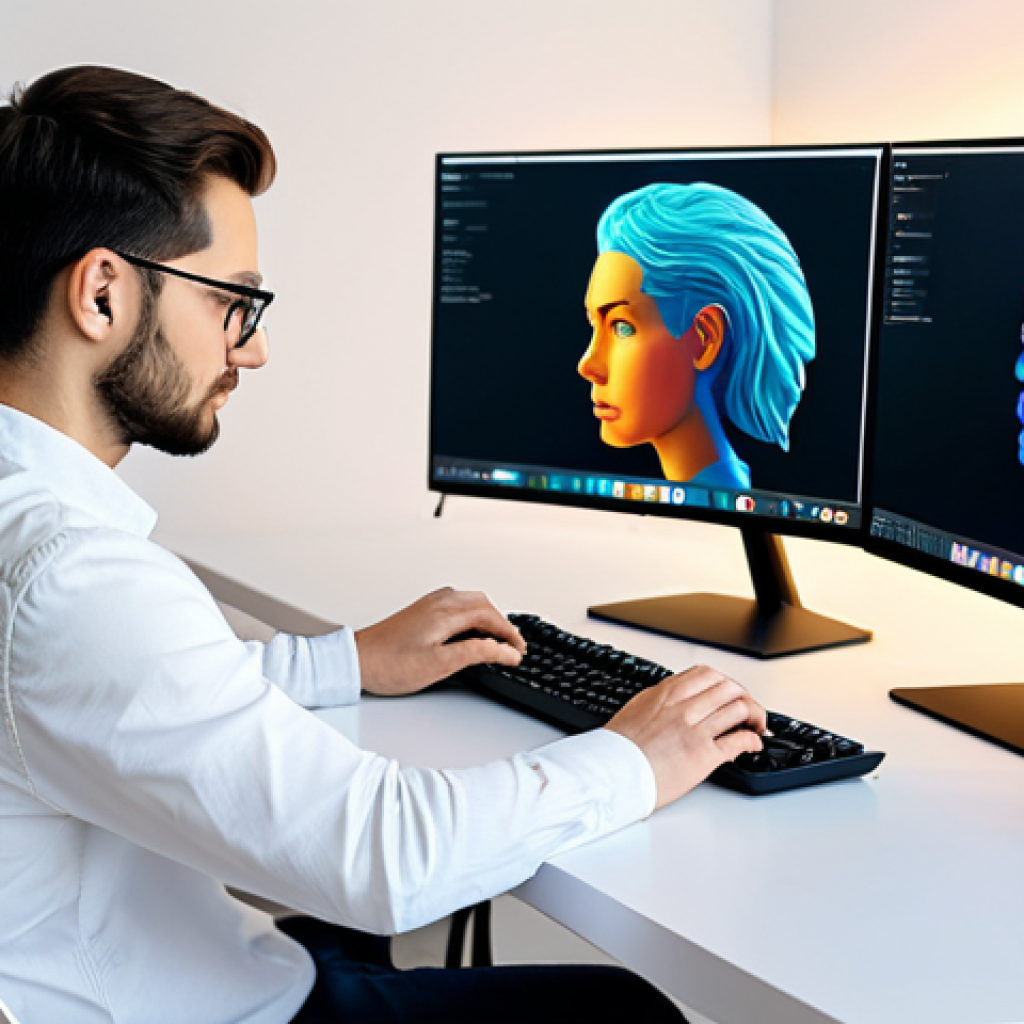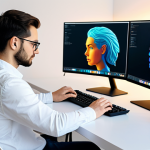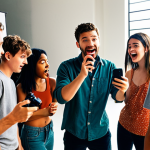Remember when simply editing a photo felt like a major accomplishment? Gosh, it feels like just yesterday, but the world of multimedia content creation has absolutely exploded since then.
What I’ve personally witnessed, and honestly, what keeps me on the edge of my seat, is the seismic shift brought about by generative AI. It’s not just about automating tasks anymore; we’re talking about systems that can *create* entirely new visuals, sounds, and even interactive narratives from a simple prompt.
Just think about the recent breakthroughs in real-time video synthesis or the incredibly detailed virtual environments now possible with tools that were science fiction a decade ago.
This isn’t just a tech fad; it’s fundamentally reshaping how we tell stories, engage audiences, and even consume information. From hyper-personalized advertising that adapts to your mood, to immersive VR experiences that transport you anywhere, the possibilities feel limitless.
However, with this power comes a whole new set of ethical considerations – the rise of deepfakes, copyright complexities, and the critical need for responsible AI development are major conversations we absolutely need to have.
The industry is grappling with how to balance unparalleled creativity with maintaining trust and authenticity. The future points towards even more seamless integration, where content might anticipate our needs or even respond to our emotional state, creating truly dynamic experiences we’ve only dreamed of.
Let’s dive deeper below.
The shift we’re currently witnessing in multimedia content creation, driven by generative AI, isn’t just incremental; it’s a full-blown revolution. I remember spending countless hours meticulously editing a single frame of video, or agonizing over the perfect sound effect.
Now, with a few well-placed prompts, complex visual narratives and immersive soundscapes can materialize in moments. It’s truly mind-boggling when you think about the sheer speed and complexity that these tools offer.
For creators like me, it feels like we’ve suddenly gained an entire army of assistants, ready to bring even our wildest ideas to life with unprecedented efficiency.
But it’s not just about speed; it’s about pushing the boundaries of what’s creatively possible.
The Dawn of AI-Powered Visual Storytelling: A New Creative Frontier

1. From Text to Terrabytes: Crafting Visuals with Unprecedented Ease
I vividly recall my first experiment with a text-to-image model. I typed in “a sprawling cyberpunk city at sunset, with neon signs reflecting in puddles,” and watched, mesmerized, as an image that was strikingly close to my mental picture generated before my eyes.
The initial results were rough, sure, but the potential immediately hit me like a bolt of lightning. Fast forward to today, and these tools have matured to an astonishing degree.
We’re no longer just generating static images; we’re producing high-fidelity video clips, intricate 3D models, and even entire virtual environments from simple descriptive inputs.
This has fundamentally democratized content creation, empowering indie filmmakers, game developers, and even casual social media users to produce stunning visuals without needing a massive budget or a specialist team.
I’ve personally used these tools to block out scenes for short films, create conceptual art for client pitches, and even design unique virtual backdrops for my live streams.
The iteration speed is what truly sets it apart – the ability to generate dozens of variations in minutes allows for a level of creative exploration that was simply unimaginable a few years ago.
It feels less like a tool and more like a creative partner, constantly pushing you to imagine more.
2. Beyond the Filter: Generative AI for Advanced Image & Video Manipulation
It’s not just about creating from scratch; it’s also about enhancing and transforming existing media in ways that used to require elite-level software skills and hours of dedicated effort.
Think about the ability to seamlessly change a person’s attire in a video, alter the weather in a scene, or even automatically animate still images. I’ve seen some truly remarkable applications, like using AI to upscale old family photos to incredible detail or to stabilize shaky handheld footage into buttery-smooth cinematic sequences with a single click.
For my own work, I’ve leveraged AI-powered tools to perform complex rotoscoping in seconds, remove unwanted objects from busy backgrounds, and even generate realistic visual effects like smoke or fire that seamlessly blend with existing footage.
This doesn’t just save time; it opens up a realm of creative possibilities for refining and polishing content to an almost unbelievable degree. The precision and naturalism these algorithms achieve are often indistinguishable from manually crafted work, and sometimes even surpass it.
It’s like having a master retoucher or VFX artist built right into your workflow.
Revolutionizing Audio Production and Interactive Media with AI
1. Crafting Soundscapes: From Prompts to Professional Audio Tracks
The impact of generative AI extends far beyond visuals; it’s profoundly transforming the world of audio. I’ve always been fascinated by sound design, but creating custom sound effects or original music scores can be incredibly time-consuming and expensive.
Now, with generative audio tools, I can describe a desired sound—say, “the ambient hum of a bustling cafe with distant chatter and clinking cups”—and an algorithm can generate a bespoke audio track that perfectly fits the mood.
This capability is a game-changer for podcasters, video creators, and even musicians looking for unique sonic textures. I’ve personally experimented with AI-generated music for my YouTube background tracks, and the results have been surprisingly diverse and high-quality.
It allows for rapid prototyping of musical ideas, experimentation with various genres and instruments, and even the creation of unique, non-repetitive background scores that perfectly loop.
The emotional depth and subtle nuances that these models can now produce are truly impressive, moving beyond mere noise generation to artistic composition.
2. The Future of Interaction: Dynamic Narratives and Personalized Experiences
Beyond static content, generative AI is paving the way for truly dynamic and interactive experiences. Imagine a video game where every character’s dialogue is spontaneously generated based on the player’s choices, or an educational platform that adapts its content in real-time to a student’s learning pace and understanding.
I’ve been following the developments in AI-driven narrative generation closely, and the idea of stories that evolve differently for each viewer or player is incredibly exciting.
This moves us away from passive consumption towards truly immersive and personalized engagements. For instance, I recently tried an experimental interactive story where the AI adapted the plot twists and character responses based on my emotional input, making the experience uniquely mine.
This has massive implications for advertising, education, and entertainment, allowing for content that genuinely resonates on an individual level. It’s about moving from a one-to-many broadcast model to a one-to-one adaptive experience, making content consumption feel profoundly personal and deeply engaging.
Navigating the Ethical Landscape: Trust, Authenticity, and Responsible AI
1. The Deepfake Dilemma: Confronting Misinformation and Malicious Use
As thrilling as these advancements are, we can’t ignore the significant ethical challenges they present. The rise of sophisticated deepfakes—highly realistic synthetic media that can mimic individuals’ voices and appearances—is a particular concern.
I’ve seen some truly unsettling examples that highlight the potential for misinformation, defamation, and even outright fraud. It’s a very real threat to public trust and authenticity, making it harder to discern what’s real from what’s manufactured.
This isn’t just a theoretical problem; it has tangible consequences for individuals and society. The industry, and we as creators, have a crucial role to play in developing robust detection methods and promoting responsible use.
It’s a constant tightrope walk between embracing innovation and safeguarding against its misuse. For content creators, this also means being transparent about the use of AI in our work, fostering an environment of trust with our audience.
2. Copyright, Ownership, and Compensation: Who Owns AI-Generated Content?
Another major hurdle, which I personally grapple with, is the murky legal landscape surrounding copyright and ownership of AI-generated content. If an AI generates a piece of music, who owns the copyright: the person who wrote the prompt, the company that developed the AI, or the artists whose data was used to train the model?
These aren’t simple questions, and the answers will profoundly impact the creative economy. I’ve seen artists understandably worried about their work being used without consent to train models, while others see AI as a powerful tool to augment their creativity.
Clear guidelines and legal frameworks are desperately needed to ensure fair compensation and protection for creators in this evolving ecosystem. It’s a complex dance between innovation and intellectual property rights, and getting it right is crucial for a thriving creative future.
Maximizing Impact: Practical Applications and Monetization Strategies
1. A Creator’s Toolkit: Integrating AI into Your Workflow for Efficiency and Innovation
From my own experience, integrating AI tools isn’t about replacing human creativity but augmenting it. I use AI to brainstorm ideas, generate multiple variations of a design, create quick mockups, or even draft initial scripts.
This frees up my time to focus on the higher-level creative decisions, the narrative arcs, and the emotional resonance of my content. For example, rather than spending hours sifting through stock footage, I might use an AI to generate a specific shot that matches my vision precisely.
Or, I could use it to transcribe my video automatically, saving a ton of manual labor. The key is to see AI as a powerful assistant, not a replacement.
It allows solo creators or small teams to achieve production values that were previously only possible for large studios. It levels the playing field significantly, allowing more voices and unique stories to emerge.
Here’s a quick look at how different generative AI types can empower your multimedia projects:
| AI Type | Core Function | Practical Application for Creators | Monetization Potential |
|---|---|---|---|
| Text-to-Image/Video | Generates visuals from text prompts | Concept art, social media visuals, stock footage replacement, animated shorts | Sell unique digital art, create bespoke marketing assets for clients, enhance branded content |
| Text-to-Audio/Music | Composes music/sound effects from text | Background music for videos/podcasts, custom sound effects, jingles, audio branding | License original compositions, create sound packs, offer custom audio services |
| Image/Video Editing AI | Automates complex editing tasks | Object removal, background generation, upscaling, rotoscoping, color grading | Streamline production for client work, offer specialized editing services, produce high-volume content |
| Narrative/Script AI | Assists in story development & scriptwriting | Brainstorming plot points, character dialogue, drafting initial script outlines | Develop interactive stories, accelerate content creation for ad campaigns, improve script efficiency |
2. New Avenues for Monetization: Beyond Traditional Content Models
The emergence of generative AI is opening up entirely new monetization strategies for creators. Beyond traditional ad revenue or sponsorships, we can now explore licensing unique AI-generated assets – be it custom soundscapes, niche stock footage, or bespoke 3D models.
Think about selling exclusive collections of AI-generated digital art as NFTs, or offering highly personalized content creation services using these tools.
I’ve seen creators successfully build businesses around offering “AI art commissions” or creating custom “AI voiceovers.” Moreover, the efficiency gains mean you can produce more high-quality content in less time, directly impacting your volume and potential earnings.
For instance, creating short, engaging video snippets for social media is faster than ever, leading to higher engagement and more opportunities for affiliate marketing or direct sales.
The ability to hyper-personalize content also creates opportunities for premium, tailored experiences for audiences, which can command higher price points.
It’s about leveraging the scalability of AI to create value in entirely new ways, finding your niche in this rapidly expanding digital landscape.
The Human Touch: Emotion, Authenticity, and the Future of Creation
1. Beyond the Algorithm: The Enduring Value of Human Creativity
Despite the incredible capabilities of generative AI, I firmly believe that the human element remains irreplaceable. AI can generate a thousand variations of an image, but it cannot conceptualize the profound emotional impact of a specific composition born from personal experience.
It cannot feel the joy of a creative breakthrough or the frustration of a difficult problem, both of which are integral to the human creative process.
What AI gives us is a canvas and a set of brushes that are infinitely more powerful, but the masterpiece still requires the artist’s vision, emotion, and lived experience.
My best content, the pieces that truly resonate with my audience, always come from a place of genuine emotion or a unique perspective that only a human can offer.
AI assists, it doesn’t replace the spark of imagination that makes art truly compelling. It’s about combining the efficiency of the machine with the irreplaceable soul of human ingenuity.
2. The Evolving Creator: Adapting, Learning, and Embracing the Next Wave
The most exciting part about this shift, to me, is the evolution of the creator themselves. We are no longer just masters of our chosen craft; we are becoming curators of algorithms, prompt engineers, and ethical navigators in a complex digital world.
This demands a continuous commitment to learning and adapting. What worked yesterday might be obsolete tomorrow, and that’s okay. It pushes us to be better, to innovate, and to continually redefine what it means to be a “creator.” I’m constantly experimenting with new tools, diving into forums, and sharing my findings with my community, because staying stagnant simply isn’t an option.
The future of content creation isn’t about AI vs. Human; it’s about AI *with* Human. It’s about leveraging these powerful tools to tell stories that are richer, more immersive, and more impactful than ever before, all while maintaining the authenticity and emotional core that only a human can provide.
The journey ahead is bound to be fascinating, and I, for one, am absolutely thrilled to be on it.
Wrapping Up: The Human Touch Remains Paramount
As we stand on the cusp of this breathtaking revolution, it’s clear that generative AI isn’t just a fleeting trend; it’s a fundamental shift in how we create. I’ve personally experienced the seismic impact, witnessing my workflow transform from painstaking manual labor to exhilarating creative sprints. While these tools empower us to achieve previously unimaginable feats, the heart and soul of compelling content will always be a uniquely human endeavor. Our stories, our emotions, our unique perspectives – these are the threads that AI can enhance, but never truly weave on its own.
Helpful Resources & Tips for Aspiring AI Creators
1. Dive into Online Communities: Platforms like Reddit (r/midjourney, r/stablediffusion), Discord servers, and dedicated AI art forums are incredible places to learn, share, and get inspiration from fellow creators. The collective knowledge is truly astounding.
2. Experiment Relentlessly: The best way to understand AI tools is by using them. Don’t be afraid to try different prompts, settings, and models. Many platforms offer free trials or tiers that are perfect for getting your hands dirty.
3. Follow Ethical Discussions: Stay informed about the ongoing conversations around AI ethics, deepfakes, copyright, and bias. As creators, we have a responsibility to use these powerful tools responsibly and transparently.
4. Learn Prompt Engineering: Mastering the art of writing effective prompts is becoming a crucial skill. Understand how to guide the AI to generate exactly what you envision, whether it’s for text, images, or audio.
5. Attend Webinars & Workshops: Many leading AI companies and creative platforms offer free webinars or paid workshops that delve into practical applications and advanced techniques. These can accelerate your learning curve significantly.
Key Takeaways
The multimedia content landscape is undergoing a generative AI revolution, fundamentally changing how visuals and audio are produced.
AI significantly boosts efficiency and creative possibilities, allowing creators to achieve professional-grade results faster and with fewer resources.
Navigating ethical dilemmas like deepfakes and copyright requires responsible use and transparent practices from creators.
Monetization opportunities are expanding beyond traditional models, including licensing AI-generated assets and offering specialized services.
Ultimately, human creativity, emotion, and unique vision remain irreplaceable, with AI serving as a powerful augmentative partner, not a replacement.
Frequently Asked Questions (FAQ) 📖
Q: So, the text mentions a ‘seismic shift’ brought by generative
A: I. What does that actually look like for someone creating content today, beyond just automation? A1: Oh, it’s a whole different ballgame now, honestly.
For me, someone who used to spend hours trying to perfect a single visual or just get the audio to sit right, it feels like having a team of brilliant, tirelessly creative assistants at your fingertips.
It’s not just speeding up what you already do, like automating photo adjustments. This is about being able to invent entirely new elements. I remember wrestling with a concept for a short film a while back – needed a specific futuristic cityscape but just couldn’t pull off the CGI with my limited resources.
Now? You can literally type a description – “a sprawling, neon-drenched metropolis with flying cars and holographic advertisements, seen at dusk, rainy” – and within seconds, you get something that’s not just a rough sketch, but a detailed, high-resolution image that you can then tweak.
Or, think about a musician struggling with writer’s block; generative AI can suggest entirely new melodic lines or even orchestrate a full piece based on a simple theme.
It truly empowers you to bring wild, previously unimaginable ideas to life, transforming “what if” into “here it is.” It’s exhilarating, if a little overwhelming sometimes.
Q: You touched on the ‘limitless possibilities’ but also the ethical tightrope we’re walking. What’s the biggest concern you personally grapple with when you think about generative
A: I’s impact on, say, truth or authenticity? A2: The deepfake problem, hands down. It absolutely keeps me up at night sometimes.
I mean, we’ve always had doctored photos and manipulated videos, but generative AI takes it to a terrifying new level of sophistication and accessibility.
Suddenly, seeing isn’t necessarily believing anymore. I’ve found myself watching what seems like a perfectly legitimate news clip or a viral social media post and having that gut-wrenching moment of doubt: “Is this real?
Or is this a perfectly crafted fabrication?” It erodes trust, not just in media, but in the very fabric of shared reality. Imagine a convincing video of a public figure saying something they never did, or a malicious deepfake used to spread misinformation before a major election or even within a personal relationship.
The ease with which these can be created and disseminated is chilling. It puts an immense responsibility on tech companies, content creators, and frankly, all of us, to develop robust ways to verify authenticity and to be incredibly discerning about what we consume and share.
Q: Looking ahead, the text mentions content that might ‘anticipate our needs or even respond to our emotional state.’ Can you give a concrete, even a bit wild, example of what that truly dynamic experience might feel like in, say, five to ten years?
A: Oh, this is where it gets truly mind-bending, in the best way! Imagine this: you’re sitting down to watch a movie after a particularly rough day at work.
Instead of just picking from a static catalog, your smart entertainment system, powered by this advanced AI, somehow senses your mood – maybe through subtle biometric cues from your smartwatch or just your recent search history for “comfort food” or “relaxing music.” It then suggests a story, not just based on genre, but dynamically adapts its narrative flow.
If you’re feeling a bit down, perhaps the pacing slows, the color palette becomes softer, and the characters offer more nuanced, empathetic dialogue. Or, conversely, if you’re buzzing with energy, it might amp up the action sequences and introduce more rapid-fire plot twists.
It’s not just recommending a show; it’s crafting a personalized narrative experience that perfectly aligns with your emotional needs in that very moment.
Think of a video game where the challenges or even the music soundtrack subtly shift based on your frustration levels, guiding you without you even realizing it.
It’s truly moving towards content that doesn’t just entertain, but resonates with you on an almost subconscious, emotional level – a dream we’ve had for ages, finally coming to life.
📚 References
Wikipedia Encyclopedia
구글 검색 결과
구글 검색 결과
구글 검색 결과
구글 검색 결과
구글 검색 결과




